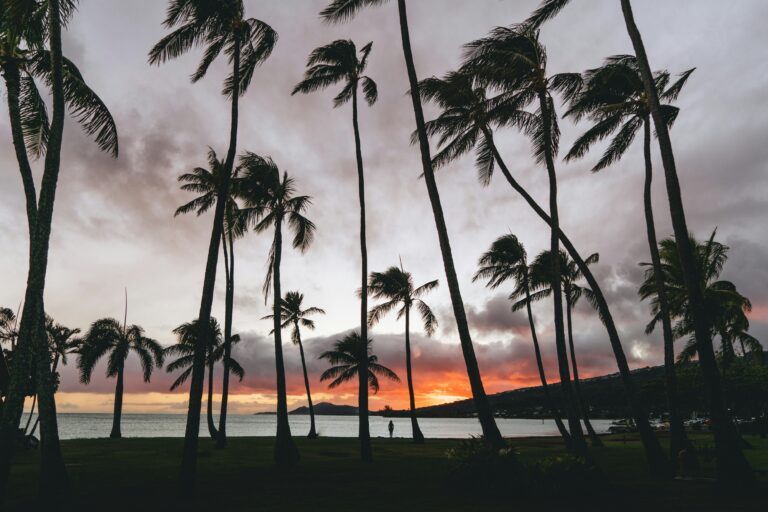History of Surfing in Hawaii: From Ancient Roots to Today
Heʻe nalu (to slide on a wave) began as a Polynesian ocean practice and grew in Hawaiʻi into a refined sport, ritual, and art. From chants of aliʻi (royalty) to modern world titles, the story of surfing is inseparable from Hawaiʻi—and now spans the globe.
The Ancient Origins of Surfing in Hawaii
Surfing’s roots stretch back thousands of years to Polynesia, where ocean peoples mastered the waves on small craft and wooden boards. In Hawaiʻi, this evolved into heʻe nalu, a cultural practice with deep spiritual meaning. Surfing was more than recreation—it was tied to ritual, community, and even status.
Traditional Hawaiian boards included:
-
Paipo — short, prone boards.
-
Alaia/Kikoʻo — thin planks for advanced surfers.
-
Olo — long, thick boards often reserved for aliʻi (chiefs).
Shaping was sacred: koa and wiliwili wood were carved with stone adzes, smoothed with sharkskin, and finished with plant oils. Offerings were made during the process, reflecting the spiritual weight of surfing.
Surfing in Polynesia and Early Hawaiian Culture
Before European contact, surfing thrived across Hawaiʻi. Breaks at Waikīkī, Mākaha, and Kona were legendary. Men, women, and children all surfed, and skill in the waves could elevate one’s prestige. Surfing was tied to mele (chants), ceremonies, wagers, and farming/fishing cycles, making it an integral part of Hawaiian society.
First Written Accounts of Surfing (1769–1779)
-
1769 (Tahiti): Naturalists on Captain James Cook’s first Pacific voyage described Polynesians riding waves.
-
1779 (Hawaiʻi): Members of Cook’s third voyage observed Native Hawaiians gliding upright across waves. Their journals provide the first European accounts of Hawaiian surfing.
Decline and Survival of Surfing in the 1800s
With the arrival of missionaries in the 1820s, Hawaiian society underwent major changes. Missionary influence, foreign diseases, and shifts in labor led to a decline in public surfing. Still, surfing never disappeared—it survived in rural communities and reemerged toward the end of the century.
The Waikīkī Renaissance and Surf Clubs (1900–1920s)
By the late 19th and early 20th centuries, Waikīkī became the epicenter of a surfing revival.
-
1866: Mark Twain wrote about surfing in Hawaiʻi.
-
1907: Jack London published A Royal Sport: Surfing in Waikiki, romanticizing the sport.
-
1908: The Outrigger Canoe Club was founded, promoting surf culture and instruction.
-
1911: Hui Nalu, a Hawaiian surf club, formed to keep surfing traditions alive.
Duke Kahanamoku: Surfing’s Global Ambassador
Duke Kahanamoku, an Olympic gold medalist swimmer (1912, 1920) and bronze medalist (1924), became surfing’s first global ambassador. Through exhibitions in California (1912) and Australia (1914–1915), Duke introduced surfing to the wider world. His graceful style and fame helped spark international fascination with surfing while keeping Hawaiʻi at the center.
Board Innovations: From Tom Blake to Fiberglass
-
1929: Tom Blake designed the first hollow surfboard, making boards lighter and easier to paddle.
-
1935: Blake introduced the fixed fin (skeg), which revolutionized control and maneuverability.
-
1940s–50s: Fiberglass and balsa boards, pioneered by innovators like Bob Simmons, led to faster, more responsive surfing.
The Birth of Big Wave Surfing in Hawaii (1950s–1960s)
Hawaiʻi became the birthplace of modern big-wave surfing:
-
Mākaha (1950s): Wally Froiseth, George Downing, Buzzy Trent, and others pioneered big-wave riding.
-
1954: The Makaha International Surfing Championships became the first major surfing contest.
-
1957: Waimea Bay was first successfully ridden, proving giant surf was possible.
Pipeline, Shortboards, and the Surfing Revolution
-
1961: Phil Edwards first surfed Pipeline; Gerry Lopez later defined its style in the 1970s.
-
1966–1969: The shortboard revolution, driven by shapers in Hawaiʻi, Australia, and California, shrank board size and unlocked radical maneuvers.
-
1971: The Pipe Masters contest began, cementing Pipeline as a proving ground.
Professional Surfing and the Hawaiian Champions
-
1976: The International Professional Surfers (IPS) launched the first world tour, co-founded by Hawaiians Fred Hemmings and Randy Rarick.
-
1983: IPS evolved into the ASP (Association of Surfing Professionals).
-
2015: ASP rebranded as the World Surf League (WSL).
Hawaiian champions include:
-
Rell Sunn: The “Queen of Mākaha,” a pioneer in women’s surfing.
-
Margo Oberg: First women’s world champion (1977).
-
Derek Ho: First Hawaiian men’s world champion (1993).
-
Sunny Garcia: World champion (2000).
-
Carissa Moore: Five-time world champion and Olympic gold medalist (2021).
-
John John Florence: Two-time world champion (2016, 2017).
Tow-In Surfing, Teahupoʻo, and the Heavy Water Era
-
1990s: Laird Hamilton, Buzzy Kerbox, and Darrick Doerner pioneered tow-in surfing at Peʻahi (Jaws), unlocking waves too big to paddle.
-
2000: Hamilton’s ride at Teahupoʻo, Tahiti, redefined heavy water surfing.
-
2000s–present: Big-wave venues like Nazaré (Portugal) and Mavericks (California) expanded the frontier, but Hawaiʻi remains the ultimate proving ground.
Surfing in the Olympics and Modern Hawaiian Icons
-
2021 (Tokyo 2020 Olympics): Surfing debuted with Carissa Moore winning gold.
-
2024 (Paris Olympics): Surfing was held at Teahupoʻo, Tahiti.
Modern Hawaiian icons:
-
Andy Irons: 3x world champion (2002–2004).
-
Carissa Moore: Olympic gold and multiple world titles.
-
Keala Kennelly: A trailblazer in women’s big-wave surfing.
Traditional Hawaiian Surfboards and Rituals
Surfing in Hawaiʻi was spiritual and cultural as much as physical:
-
Boards: Paipo, alaia, olo.
-
Rituals: Offerings and prayers before shaping; kapu (sacred restrictions) around surf spots.
This deep cultural framework still influences modern Hawaiian surfing.
Why Hawaii Remains the Heart of Surfing
-
World-class waves: From Waikīkī rollers to North Shore giants, Hawaiʻi offers unparalleled variety.
-
Living culture: Surfing remains tied to Hawaiian traditions of canoeing, navigation, and respect for the ocean.
-
Global stage: The Vans Triple Crown, the Eddie Aikau Invitational, and Pipeline continue to set performance standards for the world.
Surfing began in Polynesia but reached its highest cultural expression in Hawaiʻi. From aliʻi sliding olo boards to Carissa Moore’s Olympic gold, Hawaiʻi remains the undisputed heart of surfing’s past, present, and future.


